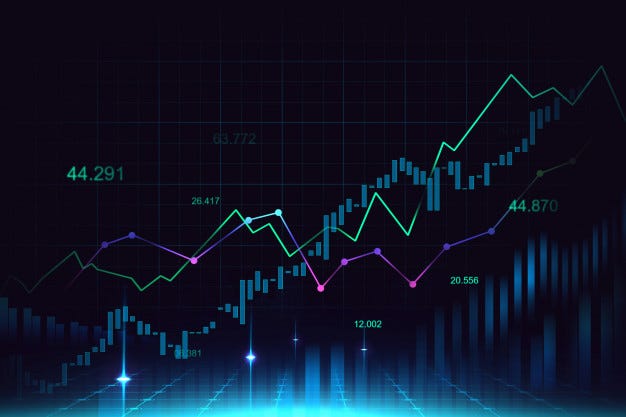The Ultimate Beginner's Guide to predict Stocks: Understanding DCF Model
You’ve probably wandered into one of those pretentious subreddits like r/ValueInvesting, where everyone’s on a quest to find “undervalued” stocks that might give +20% in the next five ice ages. And of course, they sprinkle in fancy phrases like “this isn’t value investing” or “over/undervalued” with zero context, perfect for new users who just asked a simple question like whether stock X or Y is worth buying.
Someone asks: “Is Intel a good buy?”
The replies:
- “That’s not value investing.”
- “Overvalued.”
- “Read Graham.”
Wow. thanks guys.
Here a fun fact: I’ve never actually seen a straight-up definition of what value investing really is other than the vague advice to buy a stock when its “intrinsic value” is below the current price. Sure, buddy… but how exactly are we supposed to figure out what the intrinsic value actually is?
=> Introducing DCF Model which is just one of many method to compute the intrinsic value of stocks.
If you Google "DCF model," you'll find tons of articles written by finance bro's who apparently get paid by the word. They're all filled with terms like "weighted average cost of capital," "terminal growth rates," and "enterprise value multiples", which is great if you already have a finance degree, but useless if you're just trying to figure out if Tesla is overpriced.
Thats why this blog post will give you finally clarity what the hell that thing is and more importantly how to calculate it yourself easily.
What is a DCF Model? (The Real Answer)
DCF stands for Discounted Cash Flow. It's basically a method to figure out what a company is actually worth based on the money it's going to make in the future.
Think of it like this: Your friend offers to sell you their discord server. You need to figure out if it's a good deal. You wouldn't just look at what they paid for the server boost and marketing right? You'd want to know:
- How much profit does this discord server make each year?
- Will it make more or less money in the future?
- How engaged are the members and will this server thrive in the coming years?
- What's that future money worth to me today?
That's literally what a DCF does, except with companies instead of discord servers.
The Big Picture: Why Should You Care?
Because stock prices are memes nowadays.
I'm serious. The market price of a stock can swing 20% because Elon tweeted something weird or because some analyst had a stroke. A DCF model helps you figure out what the stock should be worth based on actual business fundamentals, not vibes and Reddit hype.
The 5 Steps of a DCF Model (Using Google as an Example)
Let me walk you through how I calculate DCF at Stocknear using Google (GOOGL) as our guinea pig. Don't worry, I'll explain each term as we go.
Step 0: Choose a Metric
Might not be clear completely but you can compute the intrinsic value of a company based on different metrics which acts like a baseline to the model. I will talk at the end of the post more about it but for now just accept the fact we use Free Cash Flow as our metric to predict the intrinsic value.
Step 1: Project Free Cash Flow (The Money Machine)
What is Free Cash Flow? It's the cash a company has left over after paying all its bills and investments. Think of it as the money the company could literally hand to shareholders if it wanted to.
For Google, the most recent Free Cash Flow is $66.73 billion (yeah, with a B).
But we don't just care about today. We need to guess what it'll be in the future. So we project it out 5 years with a growth rate of 18.63% per year.
Why 18.63%? This is based on the company's historical growth over the last 5 years and we take the average of it as our baseline. Google's been growing like crazy, so we're assuming that continues (though maybe slows down a bit).
After 5 years of 18.63% growth, we estimate Google's Free Cash Flow will be $156.78 billion.
The Math: $66.73B × (1.1863)^5 = $156.78B
Step 2: Project Future Diluted Shares Outstanding
I will not explain what diluted outstanding shares are but the idea is the same as before. We look at the past 5 years and see how much it increased on average.
Google currently has 12.09 billion diluted shares outstanding.
We project this forward 5 years with a growth rate of -2.28%.
Wait, negative growth? Yep! Google's been buying back its own shares (reducing the total count).
Estimated shares in 5 years: 10.78 billion.
The Math: 12.09B × (1 - 0.0228)^5 = 10.78B
Step 3: Project Future Stock Price (The fun part)
Now we combine Steps 1 and 2 to figure out what the stock price should be in 5 years.
The Formula: (Future Free Cash Flow ÷ Future Shares) × Price Ratio
($156.78B ÷ 10.78B) × 27.91 = $406
Hold up, what's this "Price Ratio" thing? This is also called the Price-to-Free-Cash-Flow (P/FCF) multiple. It's basically what investors are willing to pay for each dollar of free cash flow.
Google's current P/FCF = Market Cap / Free Cash Flow ratio is 27.91. That means for every $1 of free cash flow, investors pay $27.91 in stock price. We're assuming this ratio stays roughly the same in 5 years.
Is $406 per share realistic? Maybe! Google's currently trading around $175-180. So if our assumptions are right, it could more than double in 5 years.
Step 4: Project Future Dividends Paid (The Bonus Points)
Google pays a small dividend: $1.02 per share annually.
Over 5 years, you'd collect roughly $5.10 in dividends per share (assuming it stays flat, which is conservative).
This gets added to your total return. It's not huge for Google, but for dividend stocks, this matters a lot more.
Step 5: Discount the Projected Stock Price (Time Machine Math)
Here's the mind-bending part: Money in the future is worth less than money today.
Why? Two reasons:
- Inflation – $100 in 2030 won't buy as much as $100 today
- Opportunity cost – You could invest that money elsewhere and earn returns
So we need to "discount" that future $406 stock price back to today's dollars.
We use a discount rate of 10% per year. This is basically saying "I need to earn at least 10% per year for this to be worth my time and risk."
The Math: $411.10 (stock price + dividends) ÷ (1.10)^5 = $255
What does $255 mean? According to this DCF model, Google's "fair value" or "intrinsic value" is $255 per share TODAY.
If it's trading at $175, the DCF suggests it's undervalued by about 45%. If it's trading at $300, it's overvalued.

Common Questions (Because I Know You're Confused)
Q: These numbers seem really specific. Are they actually accurate?
A: Haha, no. This is educated guessing. The DCF model is only as good as your assumptions. If Google's growth slows down or speeds up, the whole thing changes. That's why we call it a "model" and not a "prophecy."
Q: Why use a 10% discount rate?
A: 10% is a common benchmark because it's roughly the average annual stock market return. You could use 8%, 12%, or whatever. Higher discount rate = lower fair value (you're more conservative). Lower discount rate = higher fair value (you're more optimistic).
Q: What if I disagree with the growth rate or other assumptions?
A: Then change them! That's the beauty of DCF. You can adjust the inputs and see how it affects the fair value. This is called sensitivity analysis, and it's super useful.
Q: Should I only buy stocks that are undervalued according to DCF?
A: Not necessarily. DCF is just one tool in the toolbox. Some of the best investments in history looked "overvalued" by DCF because the model couldn't capture things like network effects, brand value, or future innovation. Use DCF as a guide, not a religion.
Q: Wait, Why Are We Using Free Cash Flow? What About the Other Metrics?
As promised in the beginning I told you there are other metrics such as "Book Value," "Operating Income," "Operating Cash Flow," etc.
The Truth About Metrics
Here's the truth: Free Cash Flow is the gold standard for most DCF models, but it's not always the right choice. Different metrics work better for different types of companies.
Free Cash Flow (The Default Champion)
Best for: Mature, profitable companies with predictable cash generation
Examples: Google, Microsoft, Coca-Cola, Visa
Book Value (The Banker's Best Friend)
Best for: Banks, insurance companies, and financial institutions
Examples: JPMorgan Chase, Bank of America, Berkshire Hathaway
Why banks are different: Here's the thing – banks don't "make products" in the traditional sense. They take deposits, lend money, and make money on the spread. Their "inventory" is literally money itself.
For a bank, Free Cash Flow is basically meaningless because their "capital expenditures" aren't buying machines or buildings – it's lending out money. Those loans are simultaneously an expense AND an asset on the balance sheet.
Book Value (assets minus liabilities) actually makes sense here because it represents:
- The loan portfolio they've built
- The capital reserves they hold
- Their ability to generate future interest income
When a bank grows its book value by 10% per year, that's a good sign they're successfully lending, getting repaid, and building wealth.
The Simple Cheat Sheet
- → Tech, software, consumer products? → Free Cash Flow
- → Banks, insurance, or anything financial? → Book Value
- → Young company burning cash but growing fast? → Maybe skip DCF entirely and use revenue multiples instead (DCF works best for established companies)
Summary
A DCF model helps you answer one question: "Is this stock a good deal at the current price?"
- Estimating how much cash the company will generate (Step 1)
- Figuring out how many shares will exist (Step 2)
- Calculating what the stock price should be (Step 3)
- Adding in dividends (Step 4)
- Discounting everything back to today (Step 5)
Is it perfect? No. Will it make you rich overnight? Also no. But it's way better than buying stocks because "the logo looks cool" or "my fellow ape said it's going to the moon."
Want to see real DCF calculations for any stock? Check out Stocknear's DCF model tool. You can adjust the assumptions and see how it changes the fair value in real-time.
Remember: The goal isn't to predict the future perfectly. It's to make informed decisions based on reasonable assumptions. And that's way more than most investors are doing.
Now go to the world and be pretentious like r/ValueInvesting and read the book "The Intelligent Investor".
(No seriously it's a good book read it. It will help you a lot just create your own definition of "value" to find your own method).

